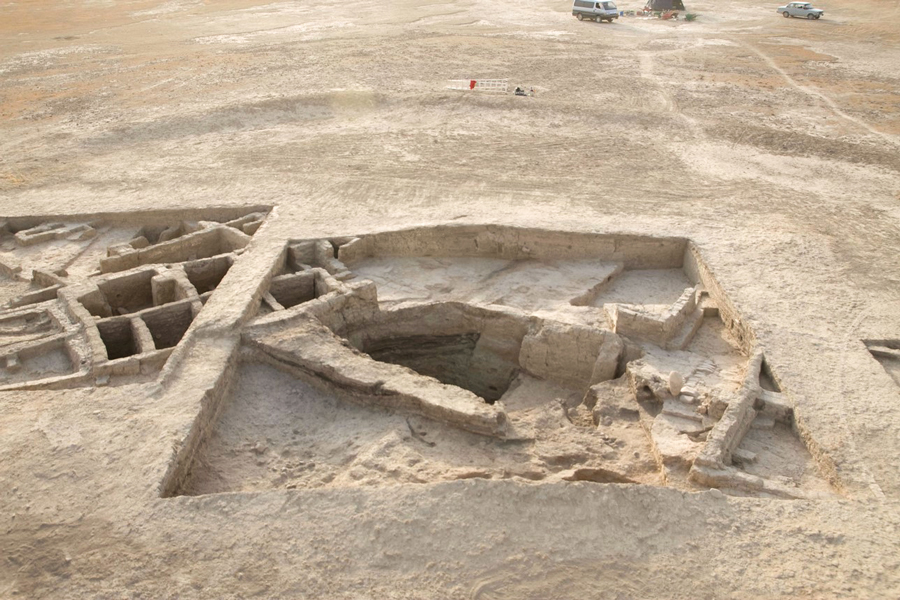This research project investigated the complex local relations between the physical environment and village economies in the late Neolithic and early Aeneolithic in the Kopet Dag piedmont zone of southern Turkmenistan. Recent research indicated that this region represents a dynamic physical and sociocultural environment, leading to frequent relocations and resettlements, sometimes within a single site.
Research
The Topoi project took as its point of departure the work conducted over the course of five field seasons at the village site of Monjukli Depe. The settlement has revealed substantial sequences of occupation, some characterized by dense architecture (see photo) and others by ephemeral surfaces and hearths, but also hiatuses between the Neolithic and Aeneolithic levels and within the Neolithic occupation as well. Earlier Soviet, Turkmen and British excavations at other sites in the region, including Jeitun, Çagylly Depe and Çakmakly Depe, also yielded indications of temporary hiatuses between and within settlement phases.

Architecture at Monjukli Depe |©Archive Monjukli Depe Project
The original goal of the Topoi project was to investigate the character of abandonment and relocation processes at Çagylly and Çakmakly Depe, both located within several kilometers of Monjukli Depe. However, unforeseen circumstances prevented the planned soundings at those two sites. Instead, the members of the project have turned to more detailed analyses of the stratigraphic sequences at Monjukli Depe, an extensive program of radiocarbon dating, and comparisons of practices over time, together with settlement and paleoenvironmental studies in the region.
Results
- Stratigraphic analyses: Moving beyond the normal coarse stratigraphic divisions that are dependent on building levels, the investigations examine the detailed trajectories (“biographies”) of houses. These allow a differentiation of specific steps in construction as well as refurbishing or the emplacement of new installations, locations of specific activities within the house, abandonment, and the subsequent reuse of the area. Similar procedures are followed for outdoor spaces without architecture. Compiling these biographies into an intricate account of the occupation of the settlement, the subject of the PhD dissertation (A-2-2-1) Tracing the change by Ilia Heit enabled to explore the settlement trajectory of the village of Monjukli Depe at a high degree of temporal and spatial resolution
- Radiocarbon dating: Supporting and extending the stratigraphic analysis is a program of radiocarbon dating. A total of 40 AMS dates have been analyzed by Ilia Heit with the aid of Bayesian modelling. In addition to providing high-resolution dating for individual occupation phases as well as specific events in the settlement history, the radiocarbon sequence has also led to minor adjustments in the correlation of stratigraphic sequences between excavation units.
- Continuity of practices through time: Despite a hiatus of eight or nine centuries between the Neolithic and Aeneolithic occupations at Monjukli Depe, examination of practices such as the layout of architectural space or the making of fire show remarkable continuities between the two settlement periods (Bernbeck and Pollock 2016). Other practices reveal more variability across much shorter periods of time. The interpretations of these different rhythms of change and their relationship to the details of settlement history appeared in: Susan Pollock and Reinhard Bernbeck, Looking Closely. Excavations at Monjukli Depe, 2010-2014.
- Regional studies: In order to understand the physical environment in which the settlement history of Monjukli Depe was embedded, geoarchaeological work was conducted to explore the fluvial history of the region (Berking and Beckers in Pollock et al. | Berking et al. ). Together with a local settlement survey (Castro Gessner in Pollock et al. ) , this work around Monjukli Depe enables us to better understand long-term trajectories as well as the availability of water resources to ancient villagers.
Two workshops connected to this research were organized by project members (Jana Eger, Ilia Heit, Birgül Ögüt, Reinhard Bernbeck). One was concerned with the history of research in Soviet times (Zwischen reichem Vermächtnis und schwerem Erbe), the other examined Scales of Movement in Early Village Societies. Both workshops included international speakers.
